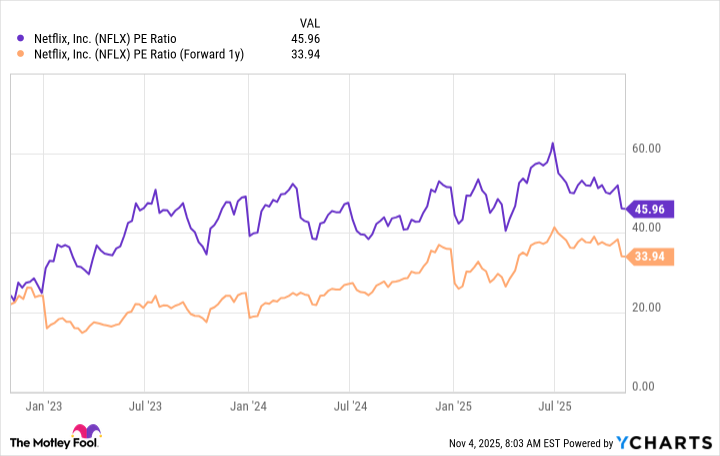High-growth companies often create so much value over the long term that their stock price soars into the hundreds or even thousands of dollars. It then becomes more difficult for investors with small portfolios to buy one whole share, so unless their broker offers fractional shares, they could be forced to sit on the sidelines.
A company can alleviate that problem by executing a stock split, which increases the number of shares in circulation and proportionately decreases the price per share. For example, a 10-for-1 stock split would increase the company's share count tenfold and reduce the price per share by 90%. It doesn't change the value of the underlying company, but it allows investors to buy shares at a much lower price point.
Netflix (NFLX +0.41%) stock is trading at over $1,100 (as of Nov. 6), but the company announced a 10-for-1 split last month, which will take effect on Nov. 17. It will be the company's third stock split since going public in 2002, which isn't surprising considering its return of 102,570% since then.
Although splits don't fundamentally add value to a business, stocks often experience gains in the wake of a split as investors who were previously priced out of ownership buy in. With that in mind, should investors buy Netflix ahead of Nov. 17?

Image source: Netflix.
Netflix is the world's largest streaming platform
Netflix had over 300 million subscribers at the end of 2024, making it the largest streaming platform for movies and television shows in the world. Even though the company no longer reports its membership numbers, its key competitor -- Walt Disney -- was still way behind as of June this year with just 128 million subscribers for its Disney+ service.
Netflix continues to attract new members through a variety of innovative strategies. First, it launched a more affordable ad-supported subscription tier in 2022 priced at just $7.99 per month.
This offering now regularly accounts for half of new sign-ups in countries where it's available, and each member becomes more valuable over time because Netflix can charge businesses more money for advertising slots as the user base grows. Last year, its advertising revenue doubled, and it's on track to more than double again in 2025.

NASDAQ: NFLX
Key Data Points
Live programming is another major draw for new members. Last December, Netflix was the exclusive network for both Christmas Day National Football League (NFL) games, and they both attracted over 30 million viewers, which made them the most streamed games in the history of the sport. The platform is scheduled to host both games again this coming Christmas Day.
Netflix is also betting big on boxing. It exclusively aired the Jake Paul vs. Mike Tyson bout last November, which was a raging success. It followed that up with several matches in 2025, including Canelo Álvarez vs. Terence Crawford in September, which drew a record 41 million viewers, the most for a men's title bout this century.
Should you buy Netflix ahead of its stock split?
Netflix has become a financial powerhouse. It generated $11.5 billion in revenue during the third quarter of 2025, which was up 17.2% from the year-ago period. That was the fastest growth rate in four years (since the second quarter of 2021), highlighting the success of initiatives like advertising and live programming.
The company is also one of the very few pure-play streaming providers generating consistent profits, delivering $10.4 billion in net income over the last four quarters alone, which translated to earnings of $23.94 per share. This allows the company to outspend its competitors to create and license content, solidifying its dominance.
With all of that said, the stock isn't cheap. It's trading at a price-to-earnings ratio (P/E) of 45.9 as of this writing, which is a hefty premium to the 34.7 P/E ratio of the Nasdaq-100 index. In other words, Netflix is considerably more expensive than many of its peers in the tech and tech-adjacent industries, so short-term investors expecting big gains over the next few months might be left disappointed.
However, Wall Street's consensus estimate (provided by Yahoo! Finance) suggests Netflix will grow its earnings to $32.34 per share in 2026 (this will become $3.23 after the 10-for-1 stock split), placing its stock at a forward P/E of 33.9.
Data by YCharts.
That means the stock will have to soar 35% by the end of next year just to maintain its current P/E of 45.9. Despite being more expensive than the Nasdaq-100, this scenario isn't out of the question considering Netflix's P/E multiple has averaged around 44 over the last three years.
But long-term investors who are willing to hold Netflix stock for the next five years or more should enjoy the best returns because that time frame will give the company's advertising business the runway it needs to grow and mature.
In summary, whether investors should buy Netflix ahead of Nov. 17 -- which is the first day of trading after the 10-for-1 split -- depends entirely on their time horizon. Short-term investors might want to stay on the sidelines, whereas their long-term counterparts could do very well in the coming years.







